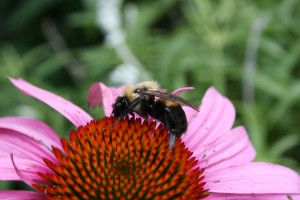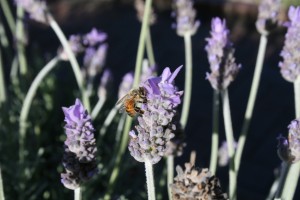—by Dr. Raymond Cloyd
Honey bees and bumble bees are important pollinators of many horticultural crops including vegetables, and ornamental plants in gardens and landscapes. As the weather warms, both pollinators will become more active visiting the flowers of plants in bloom. However, how different are honey bees and bumble bees?
There are a number of behavioral differences associated with honey bees and bumble bees that are presented below:
- Bumble bees are more active at lower temperatures (40°F) whereas honey bees are primarily active when temperatures are around 60°F or higher.
- Bumble bees are active on cloudy and rainy days. Honey bees are less active at low light intensities.
- Bumble bees “buzz pollinate” flowers so only a single bumble bee is required for pollination whereas up to 7 honey bees may be needed to pollinate a flower.
- Bumble bees forage for pollen instead of nectar. They are also more efficient pollinators than honey bees because they visit more flowers in a designated time period (e.g., minute).
- Bumble bees are present longer during the day (early morning and late evening) than honey bees, which means they may be more susceptible to exposure from pesticide applications.
It is important to protect honey bees and bumble bees from exposure to pesticides including insecticides and fungicides. So, when using pesticides be sure to adhere to the following:
- Use pesticides according to the label (ALWAYS READ THE LABEL DIRECTIONS CAREFULLY).
- Apply pesticides when both honey bees and bumble bees are less active (early morning and later evening).
- Apply more selective pesticides such as Bacillus thuringiensis subsp. kurstaki (sold as Dipel), which is only active on caterpillars.
- “Bee-Careful” when applying any pesticides. For example, avoid directly applying pesticides to open flowers that may be visited by honey bees or bumble bees.

